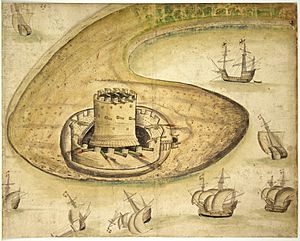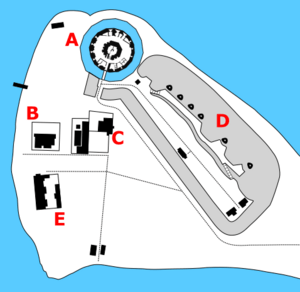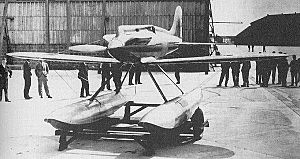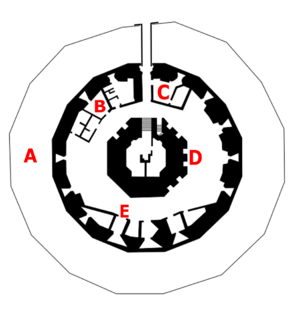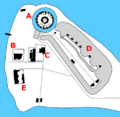Calshot Castle facts for kids
Quick facts for kids Calshot Castle |
|
|---|---|
| Calshot Spit, Hampshire | |
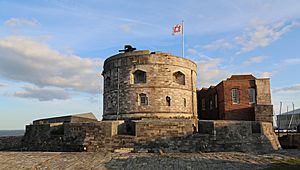
Calshot Castle
|
|
| Coordinates | 50°49′12″N 1°18′27″W / 50.8200°N 1.3075°W |
| Type | Device Fort |
| Site information | |
| Owner | Hampshire County Council |
| Controlled by | English Heritage |
| Official name | Calshot Castle: a 16th century artillery castle |
| Designated | 31 December 1987 |
| Reference no. | 1014619 |
| Open to the public |
Yes |
| Site history | |
| Materials | Portland stone |
Calshot Castle is an old fort built by King Henry VIII in England. It stands on the Calshot Spit in Hampshire. The castle was built between 1539 and 1540. It was part of a big plan by the King to protect England. This plan was called the "Device programme". The goal was to stop invasions from France and the Holy Roman Empire. It also guarded Southampton Water where it meets the Solent.
The castle had a strong central keep. This was surrounded by a thick curtain wall and a moat. At first, it had many guns, up to 36 cannons. About 16 soldiers lived there. Calshot Castle was used for many years. It survived the English Civil War without damage. It was updated in the 1770s.
In the 1800s, the castle was used by the coastguard. They used it to fight against smuggling. But in 1894, fears of a French invasion returned. So, the castle became a military fort again. A large coastal battery was built next to it. A special barrier, called a boom, was placed across Southampton Water. The castle controlled this boom.
During the First World War, Calshot Castle became a base for seaplanes. These planes flew patrols against submarines in the English Channel. Its guns were removed before the war ended. The air base grew and was named RAF Calshot. It even hosted the famous Schneider Trophy air races. When the Second World War started, Calshot was armed again. This was to prepare for a possible German invasion.
The base stayed open after the war. But military seaplanes became old-fashioned. So, it closed in 1961. After a short time with the coastguard, English Heritage opened the castle to the public in the 1980s. It was restored to look like it did before 1914. Historic England says Calshot is a "well-preserved example" of King Henry's forts.
Contents
History of Calshot Castle
Building a Royal Fortress
Why Henry VIII Built Forts
Calshot Castle was built because of big problems between England, France, and the Holy Roman Empire. This happened in the last years of King Henry VIII's rule. Before this, local lords usually handled coastal defenses. The King did not do much to build forts. France and the Empire often fought. So, sea raids were common. But a real invasion of England seemed unlikely. Most defenses were small towers.
In 1533, Henry VIII broke away from the Pope. This was because the Pope would not let him end his marriage to Catherine of Aragon. Catherine was the aunt of Charles V, the Holy Roman Emperor. Charles V felt insulted. In 1538, France and the Empire joined together against Henry. The Pope even told them to attack England. It looked like England would be invaded. So, in 1539, Henry ordered new forts to be built. This was called a "device" or plan. It was for "defence of the realm in time of invasion".
Calshot's Important Location
Calshot Castle was built to protect the Solent. The Solent is a waterway that leads from the English Channel to Portsmouth. Portsmouth was an important naval base. It also led to Southampton through Southampton Water. Southampton was a busy port. Calshot was one of four forts planned for the Solent. The others were at East and West Cowes, and Hurst.
Calshot was built on the narrow Calshot Spit. It watched over the deep channel into Southampton. Temporary defenses were put up first. But the castle itself was built very fast. It was finished by the end of 1540. Workers probably used stone and lead from nearby abbeys. These abbeys had recently been closed by the King.
Early Days and Changes
At first, the castle had a captain, a lieutenant, five soldiers, and eight gunners. In the late 1540s, it had 36 cannons. This was a lot for that time. In the 1580s, the castle caught fire. Wood for repairs came from the New Forest. This work was done in 1584. It was because Spain threatened to invade. But by then, only eight men were living there.
Calshot Through the Centuries
From Peace to War and Back
In the early 1600s, England was peaceful. So, coastal forts were not given much attention. During the English Civil War in the 1640s, Calshot was held by Parliamentary forces. They fought against King Charles I. The castle had 15 soldiers. Parliament thought the fort was important. They kept it supplied with ammunition. It stayed open to protect Southampton Water. In the early 1700s, during the War of the Spanish Succession, it had up to 25 guns.
The castle was updated in the 1770s. A new wall was built around the central keep. Changes were made to the gun openings. The gatehouse was made bigger. It got new rooms for the captain. But in 1793, reports said the castle's guns were in bad shape. The fort was run by an old, sick gunner. Improvements were likely made when the French Revolutionary Wars started. But in 1809, it was called just "a blockhouse with a garrison". In 1804, the castle stored weapons for the Sea Fencibles. These were volunteer naval boats. Seven guns were added to protect against French attacks.
Coastguard and New Threats
After the Napoleonic Wars ended in 1815, the government coastguard took over. They used the castle to fight smuggling. The water behind Calshot Spit was good for their boats. By the mid-1800s, two officers and 42 men were stationed there.
By the 1850s, the military was interested in the site again. There were ideas to add 32 cannons. But these plans were not carried out. It was noted that the old stone keep could create dangerous splinters if hit by enemy fire. In 1887, the Castle Yacht Club opened next to the castle.
In the 1880s, people worried that Southampton could be attacked by small torpedo boats from France. So, in 1894, the War Office took the castle back. They built a boom across Southampton Water. Three gunboats moved this boom. The old 16th-century castle was too small for a new gun battery. So, a larger battery was built south of it in 1895. It had two 4.7-inch and four 12-pounder quick-firing guns. Three searchlights were on the old castle walls. The boom was managed from two towers. One was next to the castle, the other across the water. Each had two 12-pounder guns and machine guns. The yacht club had to move because of these new defenses.
Calshot in the 20th Century
From Fort to Air Base

In the early 1900s, Calshot Castle kept its defensive role. In 1907, the castle's keep was changed. It could now hold two quick-firing guns on its roof. A new, lighter boom was put across Southampton Water in 1907. But by 1909, plans changed. They decided to block Southampton Water with floating old ships. A 1910 plan said 10 officers and 154 men would be needed in wartime. Many would have to live outside the fort. Naval staff were also needed for the boom boats.
A Royal Naval Air Station was built next to the castle in 1913. It housed 12 experimental seaplanes. These planes were to help the Royal Navy fleet in the Channel. Calshot was good for seaplanes because the waters were calm.
World Wars and Air Races
The First World War began in 1914. Ideas about Calshot Castle's use had changed. The main defenses were now at the Solent's entrances, not at Calshot. The boom was removed. Anti-submarine nets were placed further up the coast. Two of Calshot's guns were moved to protect these nets. The air base trained pilots until 1916. Then, it started anti-submarine patrols over the Channel. German attacks were causing much damage. Aircraft from Calshot flew thousands of hours. Sub-bases were set up in other towns. A cabin was built on the keep to watch air operations. The Yacht Club became the officers' mess. The air station spread across Calshot Spit. Calshot's remaining guns were removed. They were likely sent to the war front in France.
Between the wars, the Royal Air Force took over Calshot. It became RAF Calshot. It was used for naval cooperation and navigation training. The Seaplane Training Squadron moved there in 1931. The 1895 gun battery was taken down to make more space. A small railway was built along the spit. Parts of the castle moat were covered with concrete for plane parking.
Calshot hosted the Schneider Trophy air races twice. These were popular international events. They encouraged new, fast aircraft technology. Empire Air Day events were also held at Calshot. In 1935, 1,000 visitors came.
During the Second World War, soldiers from the Hampshire Regiment first defended Calshot Castle. A barge with two 3-inch anti-aircraft guns and a 40mm Bofors gun helped. Air-raid shelters were built in the castle's moat. Five boats from the base helped with the Dunkirk evacuation. The threat of German invasion grew. So, defenses were increased in 1940. Two 12-pounder guns were put on the keep's roof. Searchlights supported them. Two more batteries were built nearby. The castle was not damaged in the war. By 1943, it became a stop for passing aircraft.
Calshot Today
After the Wars and Public Access
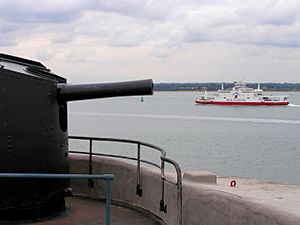
After the war, Calshot was an active air base again. It housed two squadrons of Sunderland flying boats. These planes helped in the Berlin airlift in 1948. Then, it moved to RAF Maintenance Command in 1953.
The Southampton Harbour Board built a coastguard lookout tower at the castle in 1952. The next year, they started building a signal station tower on top of the keep. It had radar and radio. It opened in 1958. But military seaplanes became old-fashioned. So, the RAF station closed in 1961.
Hampshire County Council leased the site in 1964. The castle itself was put under state care. The old aircraft hangars were used as an activity centre. A Royal National Lifeboat Institution station opened next to the castle in 1971. A new, tall coastguard tower was built two years later.
English Heritage took over the castle in 1983. They removed additions from the 1900s. They wanted it to look like it did in 1914. This included taking down the old signal station tower. The castle is still open to visitors. In 2010, 5,751 people visited. The castle is protected by UK law. It is a Grade II* listed building and a scheduled monument. The former air station hangars are still used as a recreation centre.
Calshot Castle's Design
Calshot Castle is a round, three-storey fort. It has a central keep, a gatehouse, and a curtain wall. It is mostly built from ashlar Portland stone. When it was first built in the 1500s, it was designed to hold three levels of cannons. Two levels were on the keep's second floor and roof. The third level was in the outer curtain wall. More guns could have been placed on the gatehouse roof and the keep's first floor. Historic England says it is a "well preserved example" of the Device Forts.
The castle is surrounded by a water-filled, 16-sided moat. It is about 8.8 meters wide. You cross a bridge to get to the gatehouse. The gatehouse was rebuilt in the 1700s. It was changed again in 1896. Brick buildings were added to the south. These likely gave more living space for soldiers. The gatehouse leads into what was once a 16-sided courtyard. It had 15 openings for guns in the curtain wall. The wall was made lower in the 1770s. A concrete building for searchlights, from 1896, is now along the south end.
In the middle of the castle is the keep. It is about 16 meters wide outside. The bottom floor has eight sides. The upper walls are round. This is where the captain and soldiers lived. But it was changed a lot in the 1800s and 1900s. Its outer walls have eight spaces at ground level. These were used to store ammunition. The keep's basement was changed in the 1890s. Electric generators were put in. A new, thicker concrete ceiling protected them. It might have had a stone arched roof like Hurst Castle.
The first floor of the keep has been restored. It looks like a barracks room from the early 1900s. The second floor was also changed in the late 1800s. It became another barracks room. Its ceiling has new steel girders and concrete. These support the gun battery above it. The keep's roof has two mounts for 12-pounder guns. It has their original gun-lockers. There is a 12-pounder gun on display. It was once used on a Royal Naval ship. The keep's roof was originally flat with battlements for cannons. But both the roof and battlements were removed in the 1770s.
Images for kids
-
The first-floor barracks in the keep, restored to their 1910 appearance
-
A 12-pounder (5.4 kg) quick-firing gun on the keep's roof, overlooking Southampton Water



